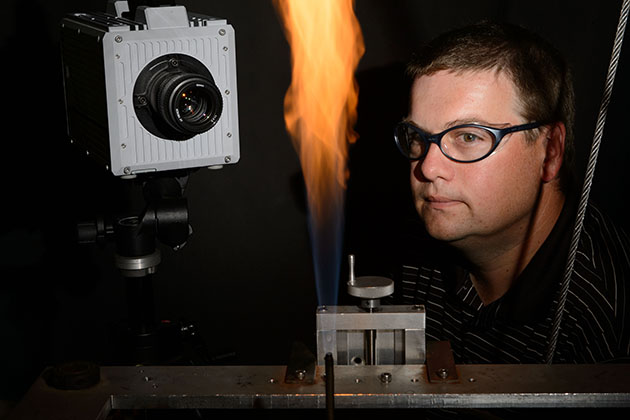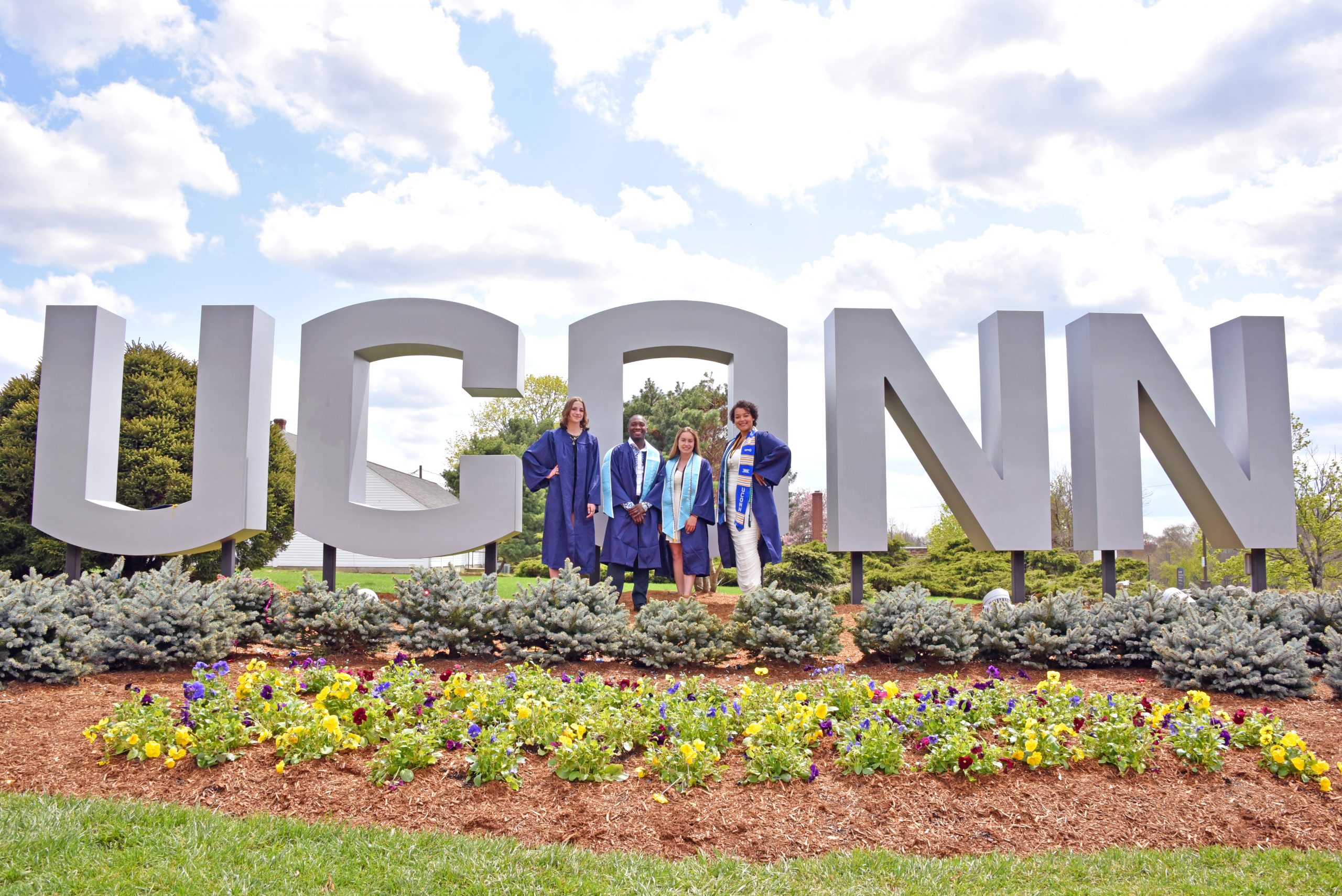
From Igor Sikorsky’s first American helicopter to Pratt & Whitney’s latest engine for the nation’s new Joint Strike Fighter jet, Connecticut has a proud history of aviation science innovation.
At UConn, researchers are doing their part by supplying Connecticut’s robust aerospace industry with innovative technologies to support a new generation of faster, more efficient, and more reliable aircraft demanded by commercial airlines and the U.S. military.
One of those scientists is Michael Renfro, UConn’s United Technologies (UTC) associate professor of engineering innovation and associate head of the Department of Mechanical Engineering. Renfro specializes in optical laser diagnostics.
Renfro and one of his research partners, Baki Cetegen, UTC chair professor and head of UConn’s mechanical engineering department, are using laser-based measurement tools to maximize the performance and stability of jet engine combustors. The research team is using similar laser diagnostic technology to better understand the basic science behind flame propagation, extinction, and instability in order to improve jet engine design.

Having reliable jet engine thrust is critical to the U.S. military, where pilots rely on their high-powered engines for supersonic flight, combat maneuvers, and short-distance take-offs on aircraft carriers.
Engineers currently use computer models and other design tools to develop new jet engine combustors that are then rigorously tested to see where they will work best and where they might fail. It is a costly and time-consuming process. For some operating conditions, pressure oscillations can become so large that combustion is extinguished, leading to flame blowout, Renfro says.
As part of a research project funded by the National Science Foundation and supported by Pratt & Whitney, Renfro and Cetegen have developed an apparatus in their laboratory that allows them to create, hold, and analyze a turbulent flame at the brink of flameout. Flame blowouts can happen in microseconds, making them difficult to study in real time. The team uses high-speed measurements that have enabled them to more reliably predict when a flame will extinguish. The information they are developing is vital to jet engine designers.
“Pratt & Whitney is using our research to find out why flames go out in the first place, which will allow them to refine their design process rather than having it based simply on accumulated data,” Renfro says.
Jeffery Lovett, an aerothermal fellow at Pratt & Whitney familiar with Renfro’s research, says: “This work will uncover the fundamental processes causing flame blowout, which we can use to predict this in the more complicated environment of the engine.”
Predicting flame extinction
A separate experiment Renfro developed with support from the National Science Foundation allows the UConn researchers to study how flames react under different fuel-air mixtures and what happens when different levels of turbulence and different velocities are introduced into the combustion chamber.
One of the things Renfro discovered through these tests is that the velocity of the gases moving along a flame has a much more critical role in preventing extinction than previously understood.
“With this burner we have developed, we can vary the flow of air and gases through the flame and measure that correlation,” Renfro says. “By doing that, we can predict when we’ll have extinction. That’s important because if a designer uses the wrong correlation, they might predict the flame will extinguish at one point in the process rather than another, and then attempt to fix the wrong thing.”
Ceramic coatings study
In a third project, Renfro – along with UTC Professor of Advanced Materials Processing Eric Jordan, an expert on ceramic coatings – has developed a novel method of measuring stress and damage in the protective ceramic coatings applied to turbine engine blades to prolong their life. Turbine engine blades are exposed to some of the most intense heat generated by the engine, and their reliability is crucial to extending the engine’s performance.
Maintenance crews currently rely on visual inspection of the blades to judge their wear and tear and a routine maintenance schedule based on engine performance data accumulated over time. If the protective ceramic coating is severely damaged internally, cracked, or chipped, the turbine blades can be damaged and even melt under the engine’s intense temperatures.
Renfro and Jordan have refined a process using laser technology to measure stress and damage in the ceramic coatings by exciting the bonding material between the coating and the metallic blades. The energy from the laser makes the bonding material fluoresce and that fluorescence is stress-dependent, Renfro says. Through the process, the researchers can measure the wavelength of light emitted by the fluorescence to determine how strong the bond is, how much viable coating is left, and whether the blade is damaged and prone to failure.
“Dr. Jordan, in his previous work, has done correlations in his lab that show when you first make the coating, it is very high stress because the bond between the coating and the metal is stronger,” Renfro says. “As the coating cracks, the stress becomes less and less, and when it’s too low, it simply flakes off.”
Novel application
Building the laser testing process for ceramic coatings resulted in another novel use of the laser technology the research team wasn’t expecting.
Turbine jet engines – because they suck in huge amounts of outside air – are notorious for accumulating a lot of dust and other contaminants during performance, which makes testing the stress of the engine blade coatings difficult. To get around this, Renfro developed a technique that uses a pulsing laser to literally blast off the fine layer of contaminants, without damaging the underlying ceramic coating or the blades. The laser ionizes the contaminants, ripping them off the surface and making them glow. By monitoring the ionization process, the researchers can tell when all the contaminant is removed.

It’s a novel application of the same technology used by the Mars Rover to determine the chemical composition of rocks, and by experts to restore valuable paintings to their original condition if they have been touched up or altered over time. It is a very sensitive process, but one that works well in this new application, Renfro says.
“The contaminant on the turbine blades is very irregular,” Renfro says. “In some places it’s very thick and in others it’s very thin. So if you tried to sand it off you would damage the ceramic coating itself and if you tried to use chemicals, they would eat through the coating as well.”
Renfro and Jordan are currently developing an application for the technology to make it more portable for use while the engines are still in service and attached to a plane.
“Swapping out turbine engine blades is a very high maintenance cost,” says Renfro. “Anytime you open an engine, you have to take the plane off line and take the engine out, and just that round trip for maintenance on one engine can cost more than the cost of the laser equipment we’ve developed.”
The ceramic coating research is being funded by the National Science Foundation and Rolls Royce, one of the world’s leading jet engine manufacturers. The research team has patent applications pending for both the cleaning and measuring process.


